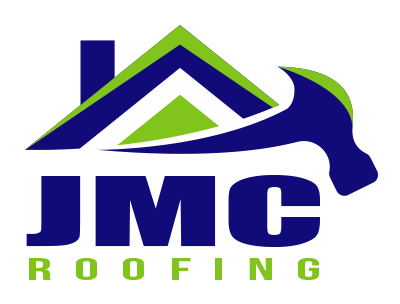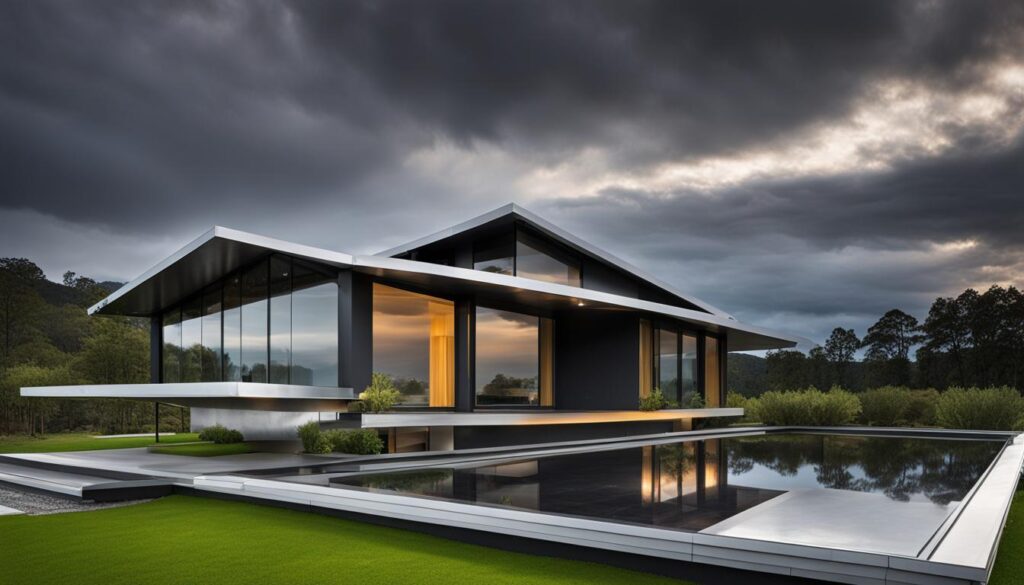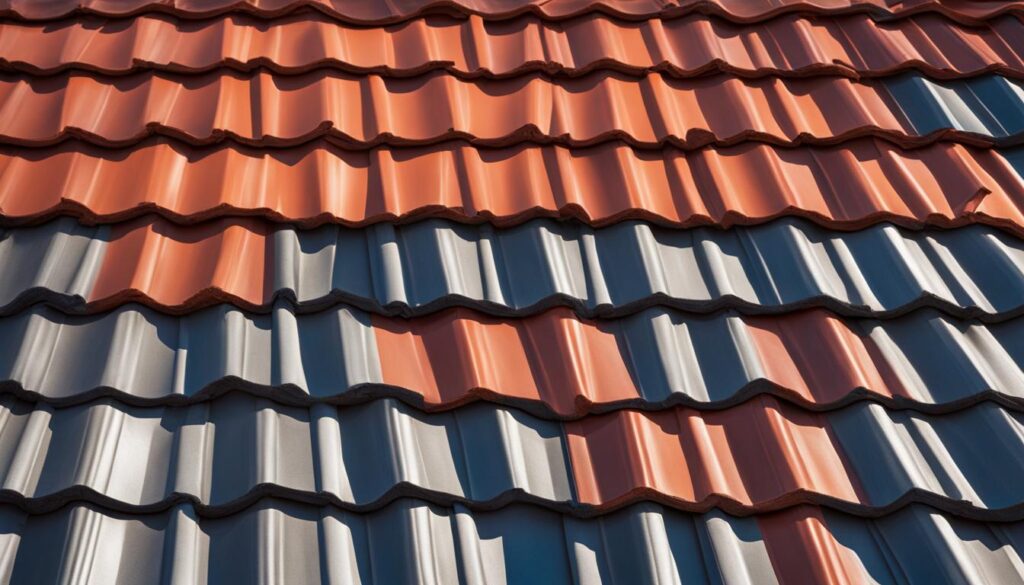- By JMC Roofing
- Uncategorized
- 0 Comment
Pros and Cons of Roofing Materials are crucial to evaluate when choosing the best fit for your home. This guide delves into the benefits and drawbacks of various roofing types. Learn about choices such as asphalt shingles, metal, cedar shake, composite, slate, and Decra, to ensure a well-informed decision for your roofing needs.
A collection of various roofing materials stacked on top of each other with a scale in the background, symbolizing the different pros and cons of each material.
Key Takeaways
- Consider the pros and cons of different roofing materials before making a decision.
- Popular roofing materials include asphalt shingles, metal roofing, cedar shake, composite, slate, and Decra roofing.
- Asphalt shingles are affordable but less durable compared to other options.
- Metal roofing offers longevity and energy efficiency, but it can be more expensive upfront.
- Cedar shake roofing has natural aesthetics but requires regular maintenance.
- Composite roofing provides a variety of styles and durability, but it may not have the same lifespan as natural materials.
- Slate roofing offers elegance and longevity but is one of the most expensive options.
Pros and Cons of Asphalt Shingles
Asphalt shingles are a popular choice for homeowners due to their affordability and wide range of options. They offer an attractive appearance with various colors and styles available to match different architectural designs. The ease of installation adds to their appeal, making them a convenient choice for both professionals and DIY enthusiasts.
One of the key advantages of asphalt shingles is their affordability. They are one of the most cost-effective roofing materials, making them accessible to a wide range of budgets. Additionally, asphalt shingles are lightweight, which means they require minimal structural support compared to heavier materials like slate or clay tiles.
However, it’s important to consider the durability factor when choosing asphalt shingles. While they provide good protection against normal weather conditions, they may not withstand extreme weather events as well as some other materials. Hail, strong winds, and heavy rainfall can cause damage to asphalt shingles, leading to the need for repairs or replacements over time.
Asphalt shingles are an affordable roofing option with a wide range of styles. While they may not be the most durable option, they provide a cost-effective solution for many homeowners.
Table: Comparison of Asphalt Shingles
| Pros | Cons |
|---|---|
| Affordable | Not as durable as some materials |
| Wide range of options | Can be susceptible to damage from extreme weather conditions |
| Easy installation |
When considering asphalt shingles for your roofing needs, weigh the affordability and ease of installation against the potential for durability issues. If you live in an area prone to extreme weather conditions, it may be worth considering alternative materials for enhanced protection and longevity. Ultimately, the choice of roofing material should align with your specific needs, budget, and aesthetic preferences.
Pros and Cons of Metal Roofing
Metal roofing is a popular choice for homeowners due to its durability and longevity. With a lifespan of 50 years or more, metal roofs offer excellent value over time. They are highly resistant to weather conditions, including strong winds, heavy rain, and even hail. This makes them suitable for various climates and environments. Metal roofs are also fire-resistant and can protect your home from potential fire hazards.
One of the key advantages of metal roofing is its energy efficiency. Metal roofs can reflect sunlight away from your home, reducing heat absorption and keeping the interior cooler. This can lead to lower energy costs for cooling your home, especially during the hot summer months. Additionally, metal roofs are environmentally friendly as they are often made with a high percentage of recycled materials and can be fully recycled at the end of their life.
However, it’s important to consider the potential drawbacks of metal roofing. The upfront cost of installing a metal roof is generally higher compared to other roofing materials. Additionally, metal roofs can be noisy during heavy rain or hailstorms, which may be a concern for some homeowners. It’s also worth noting that metal roofs can be challenging to install or repair due to their specialized installation techniques and the need for professional expertise.
Pros and Cons of Metal Roofing
Below is a table summarizing the pros and cons of metal roofing:
| Pros | Cons |
|---|---|
| Durable and long-lasting | Higher upfront cost |
| Weather-resistant | Potential for noise during heavy rain or hailstorms |
| Fire-resistant | Specialized installation and repair techniques |
| Energy-efficient | |
| Environmentally friendly |
As with any roofing material, it’s important to consider your specific needs and preferences when deciding if metal roofing is the right choice for your home. Consulting with a professional roofer can provide valuable insights and help you make an informed decision.
A sleek and modern house with a symmetrical roof made entirely out of shiny, silver metal panels. The roof glistens in the sunlight and reflects the surrounding landscape, giving the impression that the house is almost invisible. Dark storm clouds loom in the distance, but the metal roof shows no signs of wear or tear, proof of its durability against harsh weather conditions.
Pros and Cons of Cedar Shake Roofing
Cedar shake roofing is a popular choice among homeowners who value the natural aesthetics it brings to their homes. The rustic appearance of cedar shakes adds a charming and timeless appeal to any architectural design. Additionally, cedar shake roofing is an eco-friendly option as it is made from renewable resources, making it an excellent choice for environmentally conscious individuals.
One of the advantages of cedar shake roofing is its natural insulating properties. The cedar shakes act as a barrier, helping to regulate indoor temperatures and reduce energy consumption. This can result in lower heating and cooling costs, providing long-term financial benefits to homeowners.
However, it is important to consider the drawbacks of cedar shake roofing. Regular maintenance is essential to prevent issues such as rot and insect infestations. Without proper care, cedar shakes can weather and become damaged over time. Additionally, cedar shake roofing is more susceptible to wear and tear from harsh weather conditions compared to some other roofing materials.
In summary, cedar shake roofing offers a visually appealing and eco-friendly option for homeowners. Its natural aesthetics and insulating properties are key advantages, but regular maintenance is necessary to ensure its longevity. While it may require more attention compared to other roofing materials, the charm and environmental benefits of cedar shake roofing make it a popular choice for many.
Pros and Cons of Cedar Shake Roofing
| Pros | Cons |
|---|---|
| 1. Natural aesthetics enhance curb appeal. | 1. Regular maintenance is required to prevent rot and insect infestations. |
| 2. Offers natural insulation, helping regulate indoor temperatures. | 2. Cedar shakes are more susceptible to weathering and damage. |
| 3. Made from renewable resources, making it an eco-friendly choice. |
In conclusion, cedar shake roofing provides a visually appealing and eco-friendly option for homeowners. Its natural aesthetics and insulating properties are key benefits, although regular maintenance is necessary to ensure its longevity. Despite its susceptibility to weathering and damage, the charm and environmental benefits of cedar shake roofing make it a popular and sustainable choice.
Pros and Cons of Composite Roofing
Composite roofing is a versatile option that offers a wide variety of styles, making it a popular choice for homeowners who want to achieve a specific aesthetic for their homes. With composite roofing, you can mimic the appearance of other materials like wood or slate, while enjoying the benefits of increased durability and longevity.
One of the significant advantages of composite roofing is its durability. Engineered to withstand various weather conditions, pests, and fading, composite materials can provide long-lasting protection for your home. This durability ensures that your roof remains in excellent condition for years to come, reducing the need for frequent repairs or replacement.
However, it’s important to note that composite roofing can be more expensive upfront compared to some other roofing materials. The initial investment may be higher, but the long-term benefits, such as reduced maintenance and increased lifespan, can offset the initial cost. Additionally, it’s essential to consider the specific climate in which you live, as certain composite materials may perform better in certain regions.
Composite Roofing Styles
“Composite roofing offers a range of styles to suit different architectural designs. Whether you prefer the look of natural wood shakes, slate tiles, or even clay tiles, composite roofing can provide the desired aesthetic without the associated drawbacks. It’s a practical and visually appealing option for homeowners who want to enhance their home’s curb appeal.”
In summary, composite roofing offers a variety of styles that allow homeowners to achieve their desired look without compromising on durability. While it may involve a higher upfront cost, the long-term benefits make it a practical investment in the overall well-being and aesthetics of your home.
Pros and Cons of Slate Roofing
Slate roofing offers an exquisite elegance that can elevate the overall look of any home. With its sleek and natural appearance, slate roofs exude a timeless charm that is hard to match. The durability of slate is unrivaled, as it can last well over a century with proper maintenance. This makes it a wise investment for homeowners looking for a long-term solution.
In addition to its remarkable longevity, slate is also a non-combustible material, providing an extra layer of fire protection for your home. This can offer peace of mind, knowing that your roof is less susceptible to fire hazards. With slate, you can enjoy both aesthetic appeal and enhanced safety.
However, it is important to consider the downsides of slate roofing. Firstly, it is one of the most expensive options available, both in terms of materials and installation. The process of quarrying and shaping the slate, as well as the specialized installation techniques required, contribute to its higher price point. Additionally, due to its weight, slate roofs may require additional structural reinforcement, which can further increase the overall cost.
Despite these potential drawbacks, slate roofing remains a popular choice for those seeking unparalleled elegance and longevity. Its timeless beauty and exceptional durability make it a top contender for homeowners who value both style and performance.
FAQ
What are the advantages of asphalt shingles?
Asphalt shingles are affordable, have a wide range of options in terms of colors and styles, and are easy to install.
Are asphalt shingles durable?
While asphalt shingles are not as durable as some other materials, they can still provide adequate protection for your home.
What are the benefits of metal roofing?
Metal roofing is known for its durability and longevity, lasting 50 years or more. It is also resistant to weather, fire, and pests, and can provide energy efficiency by reflecting sunlight.
Is metal roofing expensive?
Metal roofing can be more expensive upfront compared to other materials, but it offers excellent long-term value due to its durability.
What are the advantages of cedar shake roofing?
Cedar shake roofing has a classic and rustic appearance, provides natural insulation, and is an eco-friendly choice made from renewable resources.
Does cedar shake roofing require maintenance?
Yes, cedar shake roofing requires regular maintenance to prevent rot and insect infestations. It is also more susceptible to weathering and damage compared to some other materials.
What are the benefits of composite roofing?
Composite roofing is a versatile option that comes in a wide range of styles. It is durable, requires less maintenance than natural materials, and can mimic the appearance of other materials like wood or slate.
Is composite roofing expensive?
Composite roofing can be more expensive upfront compared to some natural materials, but it offers durability and resistance to weather, pests, and fading.
What are the advantages of slate roofing?
Slate roofing offers a timeless and high-end look, unmatched durability lasting over a century, and an added layer of fire protection as it is non-combustible.
Is slate roofing expensive?
Yes, slate roofing is one of the most expensive options in terms of both materials and installation. It is also heavy and may require additional structural reinforcement.




